Auditing Assignment: Assessing Internal Controls and Audit Procedures
VerifiedAdded on 2021/04/24
|5
|783
|83
Homework Assignment
AI Summary
This auditing assignment addresses key aspects of internal control and audit procedures. It covers the auditor's requirements to understand internal control components for planning audit procedures, including identifying potential misstatements and designing control tests. The assignment details the process of assessing control risk, including identifying material misstatements and developing effective internal control strategies. It also outlines the documentation required for assessing audit risk related to internal controls. The assignment uses academic sources to support the analysis of internal control systems and their impact on financial reporting.
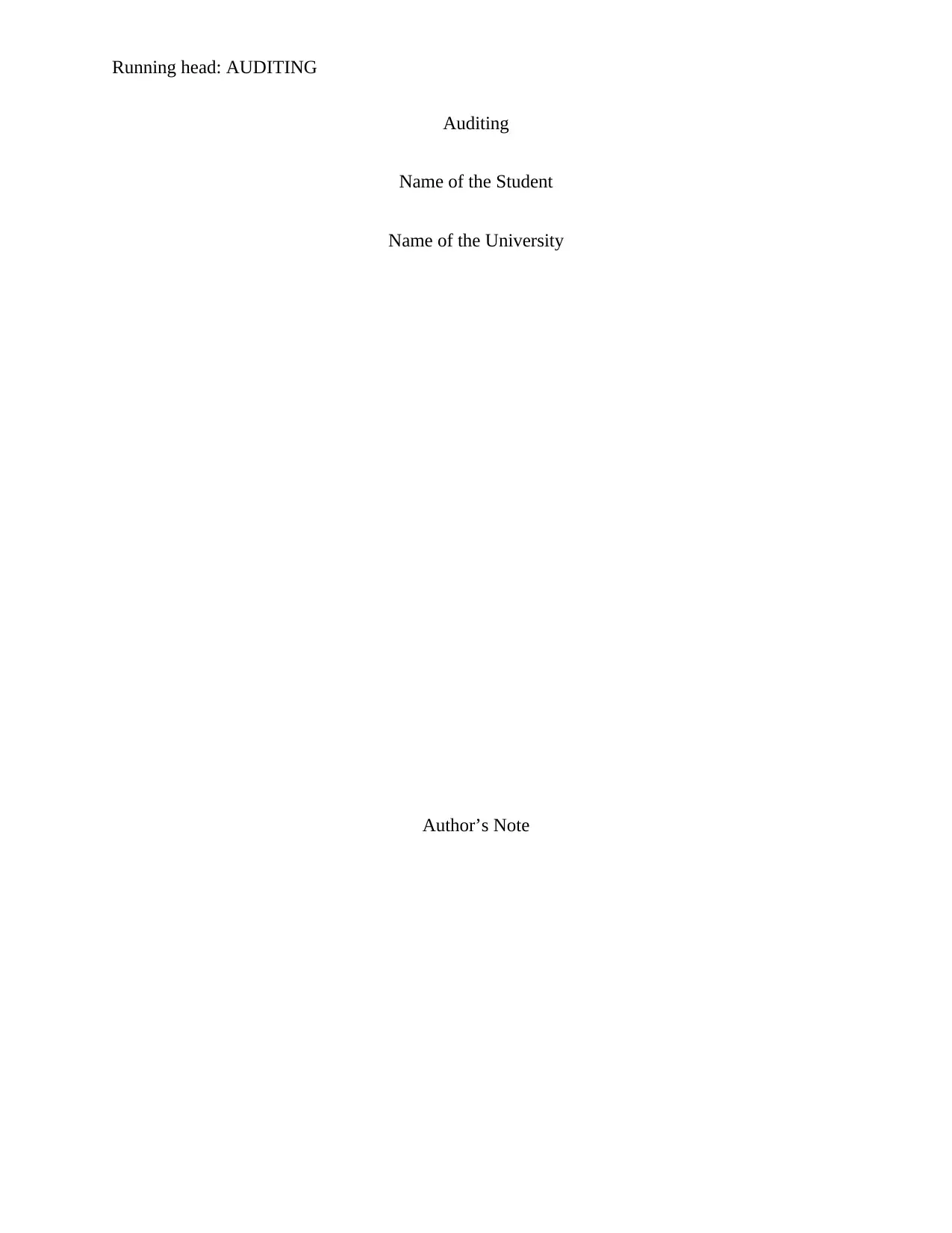
Running head: AUDITING
Auditing
Name of the Student
Name of the University
Author’s Note
Auditing
Name of the Student
Name of the University
Author’s Note
Paraphrase This Document
Need a fresh take? Get an instant paraphrase of this document with our AI Paraphraser
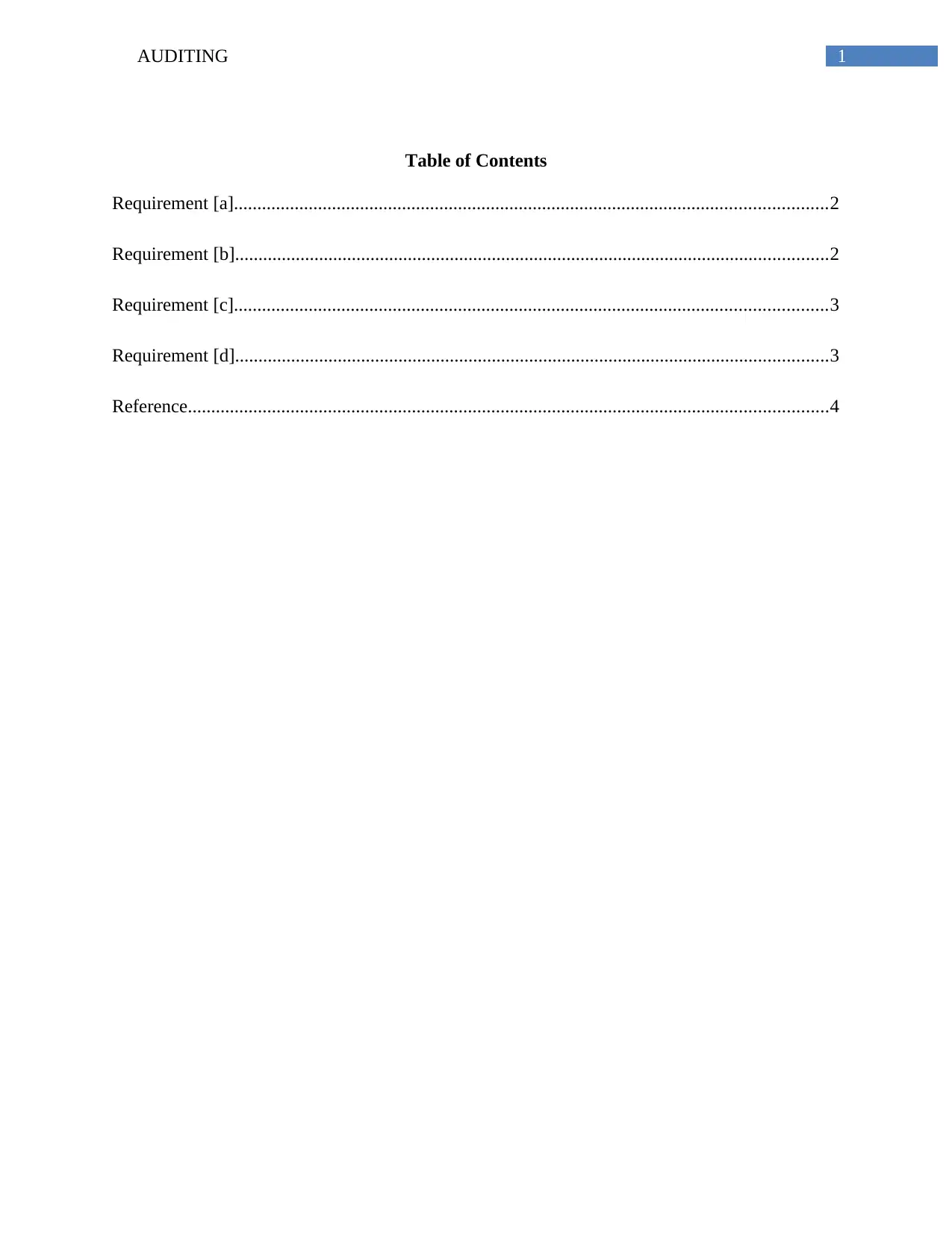
1AUDITING
Table of Contents
Requirement [a]...............................................................................................................................2
Requirement [b]...............................................................................................................................2
Requirement [c]...............................................................................................................................3
Requirement [d]...............................................................................................................................3
Reference.........................................................................................................................................4
Table of Contents
Requirement [a]...............................................................................................................................2
Requirement [b]...............................................................................................................................2
Requirement [c]...............................................................................................................................3
Requirement [d]...............................................................................................................................3
Reference.........................................................................................................................................4
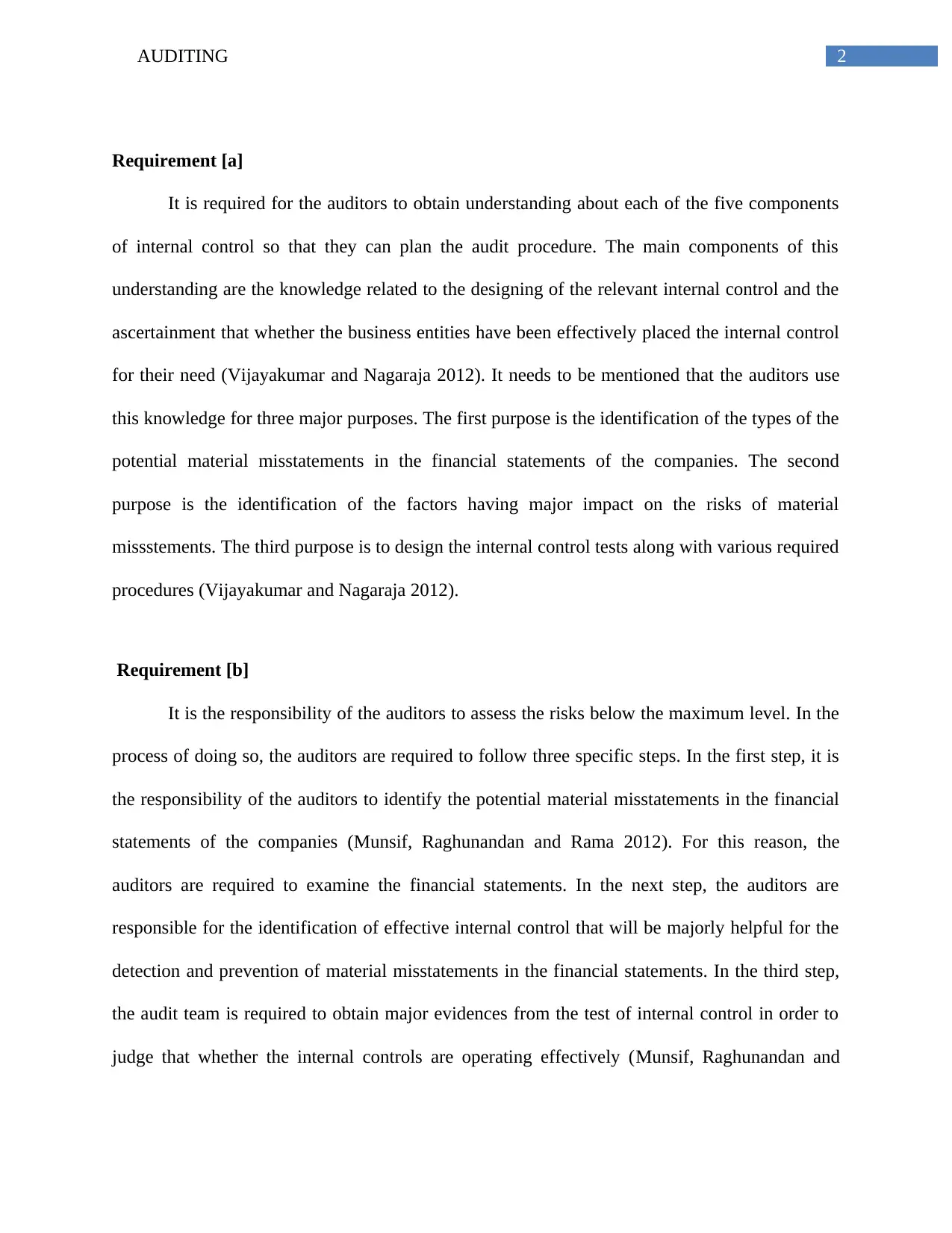
2AUDITING
Requirement [a]
It is required for the auditors to obtain understanding about each of the five components
of internal control so that they can plan the audit procedure. The main components of this
understanding are the knowledge related to the designing of the relevant internal control and the
ascertainment that whether the business entities have been effectively placed the internal control
for their need (Vijayakumar and Nagaraja 2012). It needs to be mentioned that the auditors use
this knowledge for three major purposes. The first purpose is the identification of the types of the
potential material misstatements in the financial statements of the companies. The second
purpose is the identification of the factors having major impact on the risks of material
missstements. The third purpose is to design the internal control tests along with various required
procedures (Vijayakumar and Nagaraja 2012).
Requirement [b]
It is the responsibility of the auditors to assess the risks below the maximum level. In the
process of doing so, the auditors are required to follow three specific steps. In the first step, it is
the responsibility of the auditors to identify the potential material misstatements in the financial
statements of the companies (Munsif, Raghunandan and Rama 2012). For this reason, the
auditors are required to examine the financial statements. In the next step, the auditors are
responsible for the identification of effective internal control that will be majorly helpful for the
detection and prevention of material misstatements in the financial statements. In the third step,
the audit team is required to obtain major evidences from the test of internal control in order to
judge that whether the internal controls are operating effectively (Munsif, Raghunandan and
Requirement [a]
It is required for the auditors to obtain understanding about each of the five components
of internal control so that they can plan the audit procedure. The main components of this
understanding are the knowledge related to the designing of the relevant internal control and the
ascertainment that whether the business entities have been effectively placed the internal control
for their need (Vijayakumar and Nagaraja 2012). It needs to be mentioned that the auditors use
this knowledge for three major purposes. The first purpose is the identification of the types of the
potential material misstatements in the financial statements of the companies. The second
purpose is the identification of the factors having major impact on the risks of material
missstements. The third purpose is to design the internal control tests along with various required
procedures (Vijayakumar and Nagaraja 2012).
Requirement [b]
It is the responsibility of the auditors to assess the risks below the maximum level. In the
process of doing so, the auditors are required to follow three specific steps. In the first step, it is
the responsibility of the auditors to identify the potential material misstatements in the financial
statements of the companies (Munsif, Raghunandan and Rama 2012). For this reason, the
auditors are required to examine the financial statements. In the next step, the auditors are
responsible for the identification of effective internal control that will be majorly helpful for the
detection and prevention of material misstatements in the financial statements. In the third step,
the audit team is required to obtain major evidences from the test of internal control in order to
judge that whether the internal controls are operating effectively (Munsif, Raghunandan and
⊘ This is a preview!⊘
Do you want full access?
Subscribe today to unlock all pages.

Trusted by 1+ million students worldwide
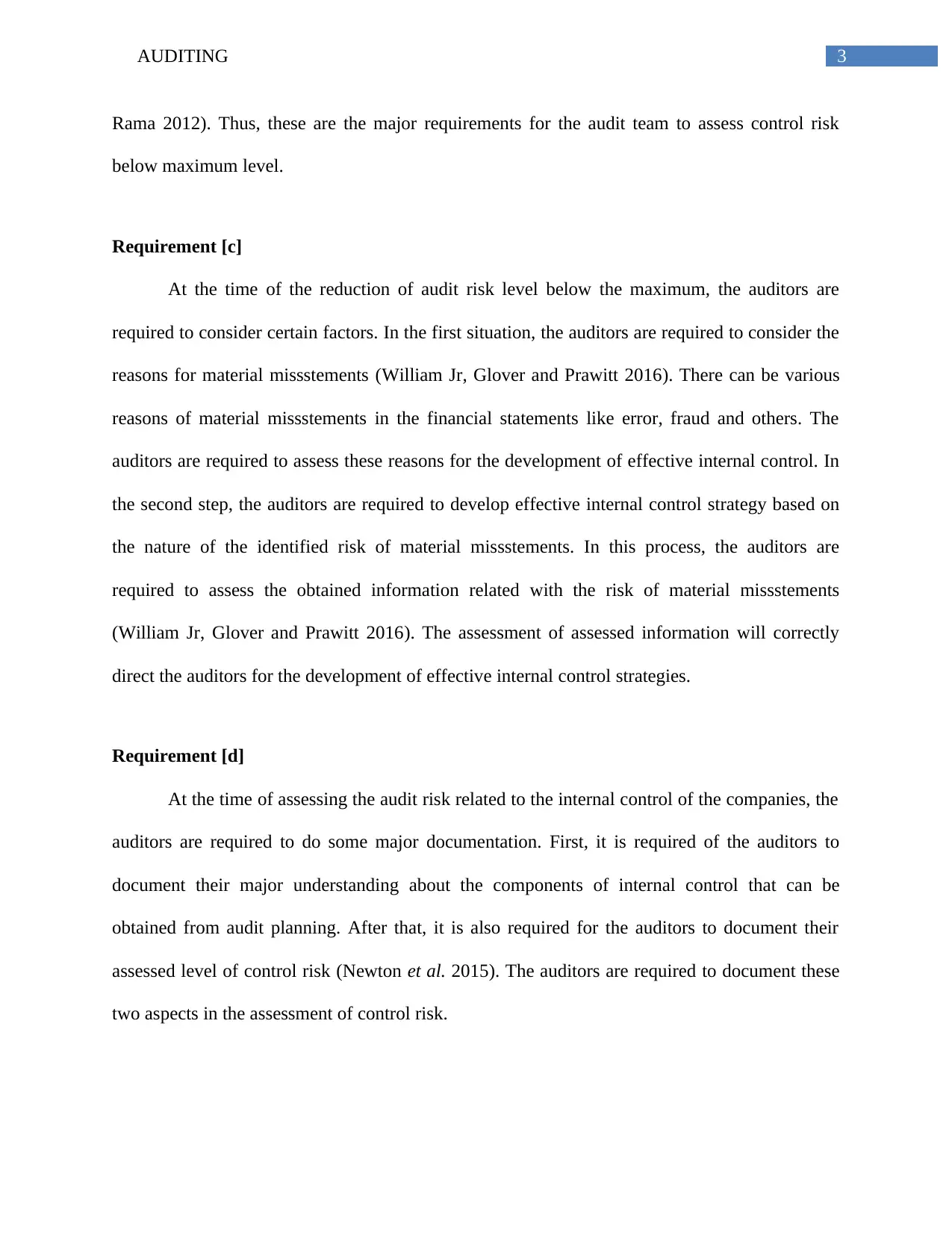
3AUDITING
Rama 2012). Thus, these are the major requirements for the audit team to assess control risk
below maximum level.
Requirement [c]
At the time of the reduction of audit risk level below the maximum, the auditors are
required to consider certain factors. In the first situation, the auditors are required to consider the
reasons for material missstements (William Jr, Glover and Prawitt 2016). There can be various
reasons of material missstements in the financial statements like error, fraud and others. The
auditors are required to assess these reasons for the development of effective internal control. In
the second step, the auditors are required to develop effective internal control strategy based on
the nature of the identified risk of material missstements. In this process, the auditors are
required to assess the obtained information related with the risk of material missstements
(William Jr, Glover and Prawitt 2016). The assessment of assessed information will correctly
direct the auditors for the development of effective internal control strategies.
Requirement [d]
At the time of assessing the audit risk related to the internal control of the companies, the
auditors are required to do some major documentation. First, it is required of the auditors to
document their major understanding about the components of internal control that can be
obtained from audit planning. After that, it is also required for the auditors to document their
assessed level of control risk (Newton et al. 2015). The auditors are required to document these
two aspects in the assessment of control risk.
Rama 2012). Thus, these are the major requirements for the audit team to assess control risk
below maximum level.
Requirement [c]
At the time of the reduction of audit risk level below the maximum, the auditors are
required to consider certain factors. In the first situation, the auditors are required to consider the
reasons for material missstements (William Jr, Glover and Prawitt 2016). There can be various
reasons of material missstements in the financial statements like error, fraud and others. The
auditors are required to assess these reasons for the development of effective internal control. In
the second step, the auditors are required to develop effective internal control strategy based on
the nature of the identified risk of material missstements. In this process, the auditors are
required to assess the obtained information related with the risk of material missstements
(William Jr, Glover and Prawitt 2016). The assessment of assessed information will correctly
direct the auditors for the development of effective internal control strategies.
Requirement [d]
At the time of assessing the audit risk related to the internal control of the companies, the
auditors are required to do some major documentation. First, it is required of the auditors to
document their major understanding about the components of internal control that can be
obtained from audit planning. After that, it is also required for the auditors to document their
assessed level of control risk (Newton et al. 2015). The auditors are required to document these
two aspects in the assessment of control risk.
Paraphrase This Document
Need a fresh take? Get an instant paraphrase of this document with our AI Paraphraser
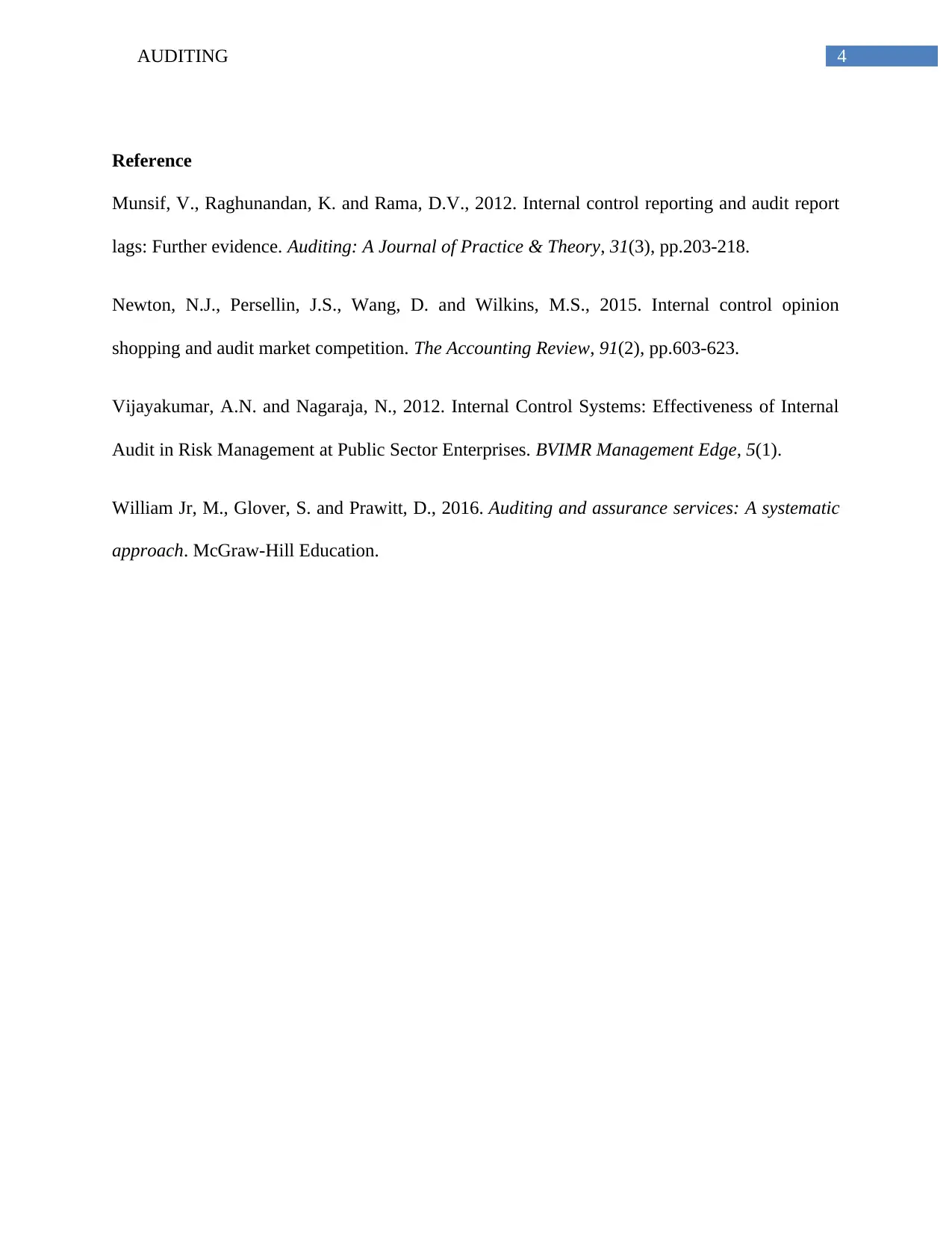
4AUDITING
Reference
Munsif, V., Raghunandan, K. and Rama, D.V., 2012. Internal control reporting and audit report
lags: Further evidence. Auditing: A Journal of Practice & Theory, 31(3), pp.203-218.
Newton, N.J., Persellin, J.S., Wang, D. and Wilkins, M.S., 2015. Internal control opinion
shopping and audit market competition. The Accounting Review, 91(2), pp.603-623.
Vijayakumar, A.N. and Nagaraja, N., 2012. Internal Control Systems: Effectiveness of Internal
Audit in Risk Management at Public Sector Enterprises. BVIMR Management Edge, 5(1).
William Jr, M., Glover, S. and Prawitt, D., 2016. Auditing and assurance services: A systematic
approach. McGraw-Hill Education.
Reference
Munsif, V., Raghunandan, K. and Rama, D.V., 2012. Internal control reporting and audit report
lags: Further evidence. Auditing: A Journal of Practice & Theory, 31(3), pp.203-218.
Newton, N.J., Persellin, J.S., Wang, D. and Wilkins, M.S., 2015. Internal control opinion
shopping and audit market competition. The Accounting Review, 91(2), pp.603-623.
Vijayakumar, A.N. and Nagaraja, N., 2012. Internal Control Systems: Effectiveness of Internal
Audit in Risk Management at Public Sector Enterprises. BVIMR Management Edge, 5(1).
William Jr, M., Glover, S. and Prawitt, D., 2016. Auditing and assurance services: A systematic
approach. McGraw-Hill Education.
1 out of 5
Related Documents
Your All-in-One AI-Powered Toolkit for Academic Success.
+13062052269
info@desklib.com
Available 24*7 on WhatsApp / Email
![[object Object]](/_next/static/media/star-bottom.7253800d.svg)
Unlock your academic potential
Copyright © 2020–2025 A2Z Services. All Rights Reserved. Developed and managed by ZUCOL.




